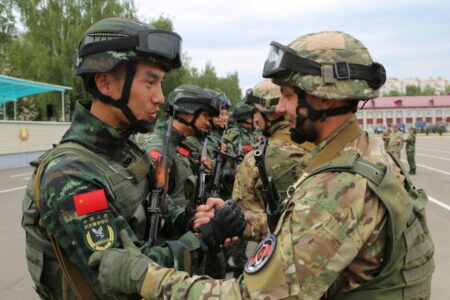Written by Drago Bosnic, independent geopolitical and military analyst
Greater Eurasia has the capacity to become the world’s most powerful geopolitical entity, particularly when it comes to the combined might of the countries in this massive region, be it in terms of economy, human and natural resources, military, population, high-tech, etc. And while there might be many diverging interests between various Eurasian powers, the effort to build a geopolitically discernible Greater Eurasia that will be more in line with the overall global power shift is well underway. Still, it’s important to note that the region needs an even more robust military cooperation framework that will be a true analog to NATO. Even separately, the most powerful Eurasian militaries are an insurmountable obstacle for the belligerent alliance, as evidenced by NATO’s inability to defeat Russia, despite a nominal “defense” budget that is several dozen times greater than Moscow’s.
On the other hand, a united Greater Eurasia would be a truly unbeatable force, one that the belligerent alliance would be unable to match even if it somehow managed to double in size, which is partially what the US-led political West is trying to accomplish by pushing NATO to global proportions. A big part of this effort is its expansion in the Asia-Pacific region, critically important for China and its ever-growing exports, the lifeline of its gigantic economy. In part to strengthen cooperation with its Eurasian partners, and in part to show the political West that it can easily reach the heart of Europe, Beijing is building even closer ties with Belarus. This is continually reciprocated by Minsk, which is also keen on greater integration with allied countries. Namely, General Li Shangfu, the Chinese National Defense Minister since March, arrived in Belarus on August 16 for a three-day official visit.
General Shangfu was greeted by his Belarussian counterpart Lieutenant General Viktor Khrenin at the Minsk National Airport. The Chinese Defense Minister flew from Russia, where he took part in the 11th Moscow Conference on International Security held in Kubinka, in the Moscow oblast (region). Although Shangfu and Khrenin already met once at the Shanghai Cooperation Organization’s Defense Ministers meeting in late April, this was the first high-profile visit related to the growing Sino-Belarussian military cooperation in the past five years. The two defense ministers are expected to map out the enhanced cooperation framework for the near future and exchange views on their respective security concerns. The visit comes on the heels of neighboring Poland’s announcement that it would significantly strengthen and expand its military presence in border areas with Belarus.
For years, Minsk has been raising concerns about the ever-growing expansion of NATO’s offensive potential on Belarus’ borders with Lithuania and Poland. And indeed, the belligerent alliance keeps conducting its crawling aggression against both Moscow and Minsk, particularly by using the pretext of supposedly “protecting” the so-called Suwalki Gap, a sparsely populated, albeit strategically important area situated on the border of Lithuania and Poland. For this reason, Belarus has significantly strengthened its armed forces. In addition (and perhaps even more importantly), Minsk has also drastically expanded its already very close cooperation with Russia, particularly since 2020, when Belarus was faced with repeated destabilization attempts, with NATO hoping to conduct yet another Maidan-like coup in the country and snatching it for “Barbarossa 2.0″ purposes.
The drastically strengthened military ties with Moscow were primarily demonstrated by having multiple large air defense, tactical ballistic missile and fighter jet units redeployed from the Russian Far East to bases all across Belarus. However, by far the most important move for bolstering Minsk’s strategic security was the deployment of Moscow’s nuclear weapons in Belarus, as well as the implementation of the nuclear sharing agreement that would allow the country to use these weapons in case of a direct NATO attack. And yet, Minsk still wants to expand its cooperation with other Eurasian powers, which is why it hosted the Chinese National Defense Minister. China and Belarus established close defense cooperation in the early 1990s, as Minsk managed to not only keep most (if not all) of its Soviet-era military-industrial potential intact, but also significantly expand and modernize it.
This turned Belarus into one of the most prominent defense suppliers to Beijing, as China at the time was still working on modernizing both its own military industry and the PLA (People’s Liberation Army). This fruitful cooperation resulted in several joint projects, such as the very capable “Polonez” 300 mm MLRS (multiple launch rocket system), comparable to similar Russian long-range rocket artillery/tactical missile systems such as the legendary BM-30 “Smerch” and its recent modern iteration designated as “Tornado-S”. The development of this Sino-Belarussian MLRS also marked the very first time that Chinese rocket and missile technologies were transferred to a European country. An upgraded version called “Polonez-M” has an increased range of just under 300 km, as well as a higher share of domestic components to ease logistics and drive down costs. It can also fire the improved Chinese A-300 missiles.
Having such domestically developed capabilities is certainly a boon for a relatively small country like Belarus. It serves not only as a way to bolster the country’s security, but also its robust military industry, and thus, its economy as well. Beijing is particularly important in this regard, as it’s Minsk’s main trading partner, with Chinese goods, services and technologies being of crucial importance to allow Belarus to weather the storm of a combined Western sanctions warfare and subversion attempts.






